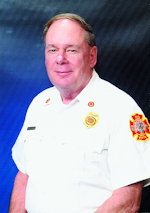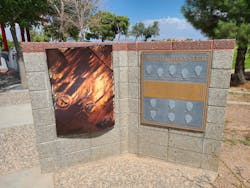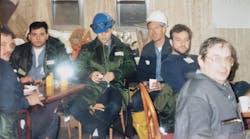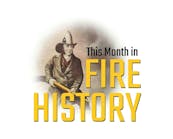During my first class at the National Fire Academy in 1981, I learned about the propane explosion (today known as a boiling liquid expanding vapor explosion, or BLEVE) in Kingman, AZ, which killed 11 firefighters (two career and nine volunteers) and one civilian. The Kingman BLEVE also is known as the Doxol Disaster, because it occurred at the Doxol Gas Western Energy Co.’s bulk plant.
The Kingman Fire Department (KFD) held a memorial service to commemorate the 50th anniversary of the Kingman BLEVE. The event was held at Lee Williams High School on July 7, 2023. Over the years since the incident, the KFD and citizens of Kingman haven’t forgotten those firefighters who gave their all. The American fire service shouldn’t forget them either.
“Forever Remembered”
Remembering the firefighters over the years never stopped in Kingman. Eleven cypress trees were planted and a monument was placed at Station 21 in honor of the heroes. A local museum has a dedicated room for the incident and the 11 firefighters. Ladder trucks carry the names of the 11 firefighters. So does the fence on the training grounds at Station 22. The station also has a memorial in front of it. Multiple challenge coins have been issued, and there are nameplates on Andy Devine Boulevard close to where the BLEVE occurred.
Lee Williams High School
Besides the renaming of Kingman High School for volunteer firefighter and principal Richard Lee Williams, other honors for the firefighters who died were implemented at the high school over the years. Multiple photographs and memorials grace its halls and walls. “Ladder 11” is the name of the school’s National Honor Society chapter. The top 11 students of each graduating class ring the bell at graduation. Home room classes dedicate time for a KFD member to speak about the incident. The school doesn’t have a mascot, but sports teams are called the Volunteers. An old hose cart that was refurbished is pulled onto the field at football games and other sports events.
The Kingman BLEVE
Kingman’s propane explosion occurred on July 5, 1973. Many changes of procedures and regulations came about nationwide as a result of the incident. It’s sad that those brave firefighters lost their life, but they are true heroes, and their actions undoubtedly saved many lives at other incidents of this type over the years.
Two Doxol workers were offloading a rail car of propane into fixed tanks at the plant. At approximately 1:57 p.m., a leak occurred at a fitting. During an attempt to stop the leak, a large wrench was used to strike the fitting. This resulted in a spark that ignited the leaking propane. Burning propane shot 70–80 feet into the air like a giant blow torch.
Flames also directly contacted the top of the surface of the rail car. When this occurred, the metal was weakened, and it failed, which caused all of the liquid contents of the tank to be released explosively. The rapidly expanding liquid to gas ignited into a large fireball. One of the workers died; another was severely burned but survived.
The KFD was summoned under the command of Chief Charlie Potter. Members applied water to the tank from handlines in an attempt to cool the tank and lower the pressure inside of it. Approximately 20 minutes after the KFD got the call, the tank BLEVE occurred. Three firefighters were killed instantly, and eight more died from their injuries over the next week in hospitals in Phoenix and Las Vegas to which they were flown.
Potter was in his pickup directing operations when the BLEVE occurred. He ducked in the seat of the vehicle but still experienced second- and third-degree burns on his arm and was hospitalized for several days.
More than 100 other people, including firefighters as well as bystanders who gathered to watch the incident, were injured, some severely.
Firefighters who lost their life
I met former KFD Fire Chief Chuck Osterman at the 35th anniversary commemoration of the Kingman BLEVE in 2008. Osterman’s father, John, was a volunteer firefighter for the KFD. The former chief is a lifelong resident of Kingman and was 17 and attending what was then Kingman High School on the day that the BLEVE occurred. He knew six of the firefighters who died at the incident from the time that he was growing up.
John O. Campbell was a volunteer firefighter. He was the assistant city works director for the city of Kingman. Campbell was married and had three children.
William (Bill) L. Casson was a volunteer captain and former chief of the department. He was married and had six children. Casson was the head of the utility department. Three of his children became firefighters. Bob Casson was a captain at the KFD. Chuck Casson was a volunteer at the KFD until the volunteer program ended around 2008. Mike Casson retired as chief of the Cottonwood, AZ, Fire Department.
Joseph M. Chambers III was a volunteer lieutenant at the KFD. He was with the department for 16 years. Chambers was married and had two children. His grandfather was one of the first firefighters to serve in that capacity in the area. Chuck Osterman grew up with Chambers’ children.
Myron B. (Jimmy) Cox was a 22-year veteran who was assistant chief when he was killed. He also was a deputy sheriff. Cox was married and had three children.
Alan Hansen was a volunteer firefighter. He was a member of the Arizona National Guard. Hansen joined the Arizona Highway Patrol in 1961 and was stationed in Wickenburg and Gila Bend before returning to Kingman in 1964. He was married and had two children.
Frank S. “Butch” Henry was a volunteer firefighter for seven years. However, he attended fires all of his life with his father, George, who retired as a 30-year veteran of the KFD. Henry was married and had two children.
Roger A. Hubka was a volunteer firefighter. He was married five months before the incident.
Christopher G. Sanders was a volunteer firefighter until April 16, 1971, when he became a career firefighter. He also was a first aid instructor. Despite his burns, Sanders worked at the incident to aid others and refused treatment until his fellow firefighters were treated. He was married and had a son and four stepchildren.
Arthur C. Stringer was a volunteer firefighter who joined the KFD one month before the incident. He was a member of the Arizona National Guard. Stringer was married and had one child, and his wife was expecting another child. Stringer’s father, who was a volunteer firefighter, was burned seriously in the incident.
Donald G. Webb was a volunteer member of the department. He was married and had two children.
Richard Lee Williams was a volunteer firefighter. He was married and had three children. His son joined another department and became a battalion chief and currently is retired.

Robert Burke
Robert Burke, who is a hazardous materials and fire protection consultant and who served as a Firehouse contributing editor, is a Certified Fire Protection Specialist (CFSP), Fire Inspector II, Fire Inspector III, Fire Investigator and Hazardous Materials Specialist. He has served on state and county hazmat teams. Burke is the author of the textbooks "Hazardous Materials Chemistry for Emergency Responders," "Counter-Terrorism for Emergency Responders," "Fire Protection: Systems and Response," "Hazmat Teams Across America" and "Hazmatology: The Science of Hazardous Materials."






